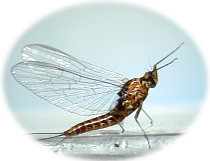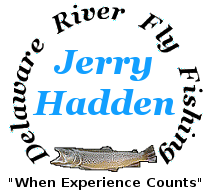

Upper Delaware River
Insect Identification
Taxonomic Ranking
Phylum, Class, Order, Family, Genus, Species.
Like all other animals insects are arranged in an order called taxonomic rank. Ranking is arranged from, Phylum that includes the widest spectrum of ranks down to the generic name that includes a number of species, to the specific name or species which applies to a single insect within the rank.
For example the Taxonomic ranking for Ephemerella subvaria would look like this, Order - Ephemeroptera Family - Ephmerellidae - Genus - Ephemerella - Species - subvaria.
For practical purposes The ranking of an insect within this article will begin from Order, and end either with the generic name (Genus), or the insects specific name (species).
Insect Identification
Insects are identified by comparing a specimen under magnification to a set of morphological keys. These keys list physical characteristics of the insect. Using these keys a determination can be made to the species level of the specimen in question. Keys to the Family are common to all insects within that broad range, for instance keys to the family Ephmerellidae would include the genus Ephemerella, Drunella, Serratella, Timpanoga, and others. Generic keys include a narrower group of insects, and would exclude insects of other genera. Keys to the genus Ephemerella would include the species subvaria, rotunda, invaria, and so on. A determination to the Generic level would look like this - Ephemerella species. Specific keys are unique to that individual species, and exclude all other species of insects. A determination to the species level would look like this Ephemerella invaria, or E. invaria.
Keys to identifying insects to the generic level include wing vein pattern, leg spurs, and spines, palps and other physical features. Determining insects to the species level relies on examining male genitalia. Keeping in mind that this program is intended for fly fisherman not entomologists listing specific keys for all of the insects in this program is somewhat beyond it's scope. However generalized identification keys for Mayfly nymphs, and duns can be found by clicking on Insect Identification, then Mayfly Nymph Genus Identification, or Mayfly Dun Genus Identification. The addition of specific keys for the Mayflies is planned for future versions of this article.
Most Caddisfly adults listed can be easily identified to the family level by comparing the photos of the wart pattern on their thorax, along with the drawings of their maxillary palps to the insect in question. Pictures of genitalia are provided for specific identification for some Caddis adults and are included with the insect's picture.
Palps are sensory organs located under the insects head, ocelli are simple eyes that unlike compound eyes have only the ability to detect light and dark. Warts are raised areas usually covered with thick hair. Please note that some of the thorax, and genitalia photos used for identification purposes are from preserved insects. The color is fadded, and will not match the color of a live specimen. The insect photos themselves are of live specimens showing the correct color.
Magnification of 10 to 35 times is required to observe the actual insects features.


